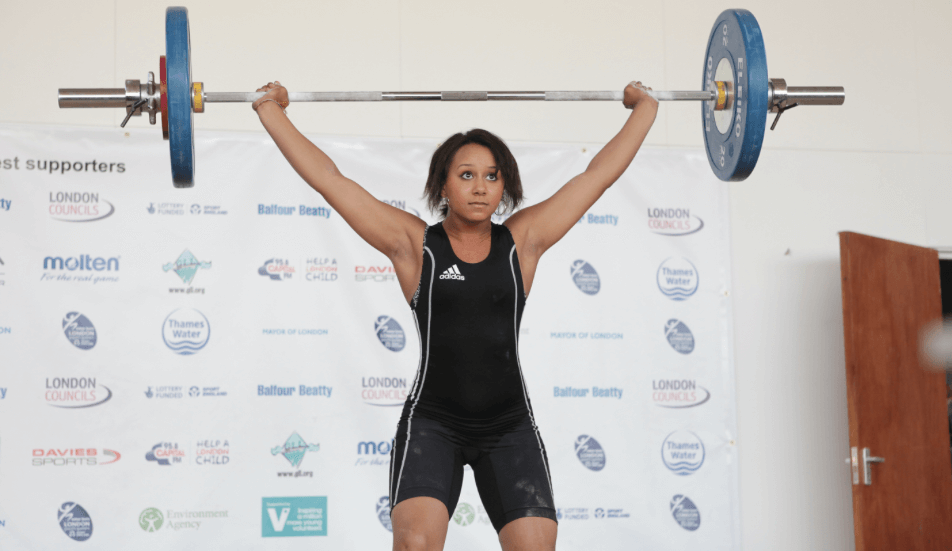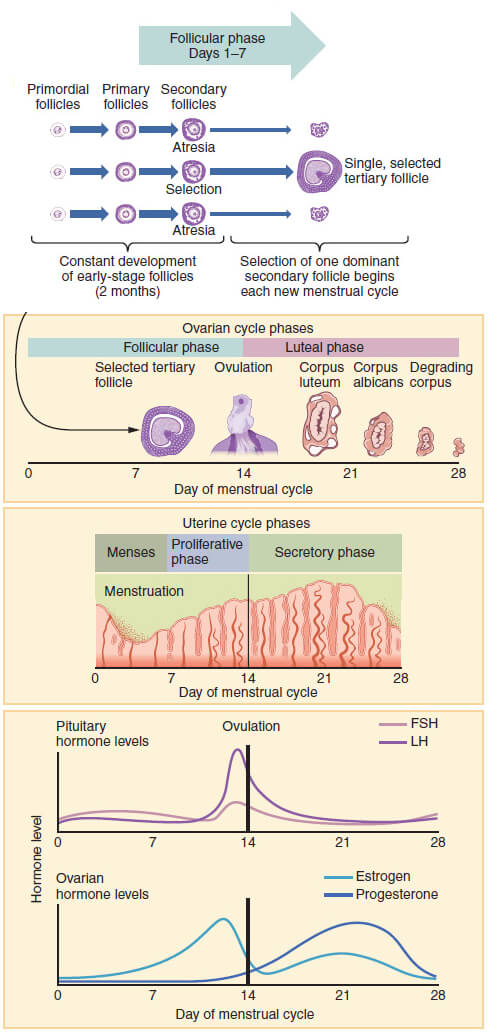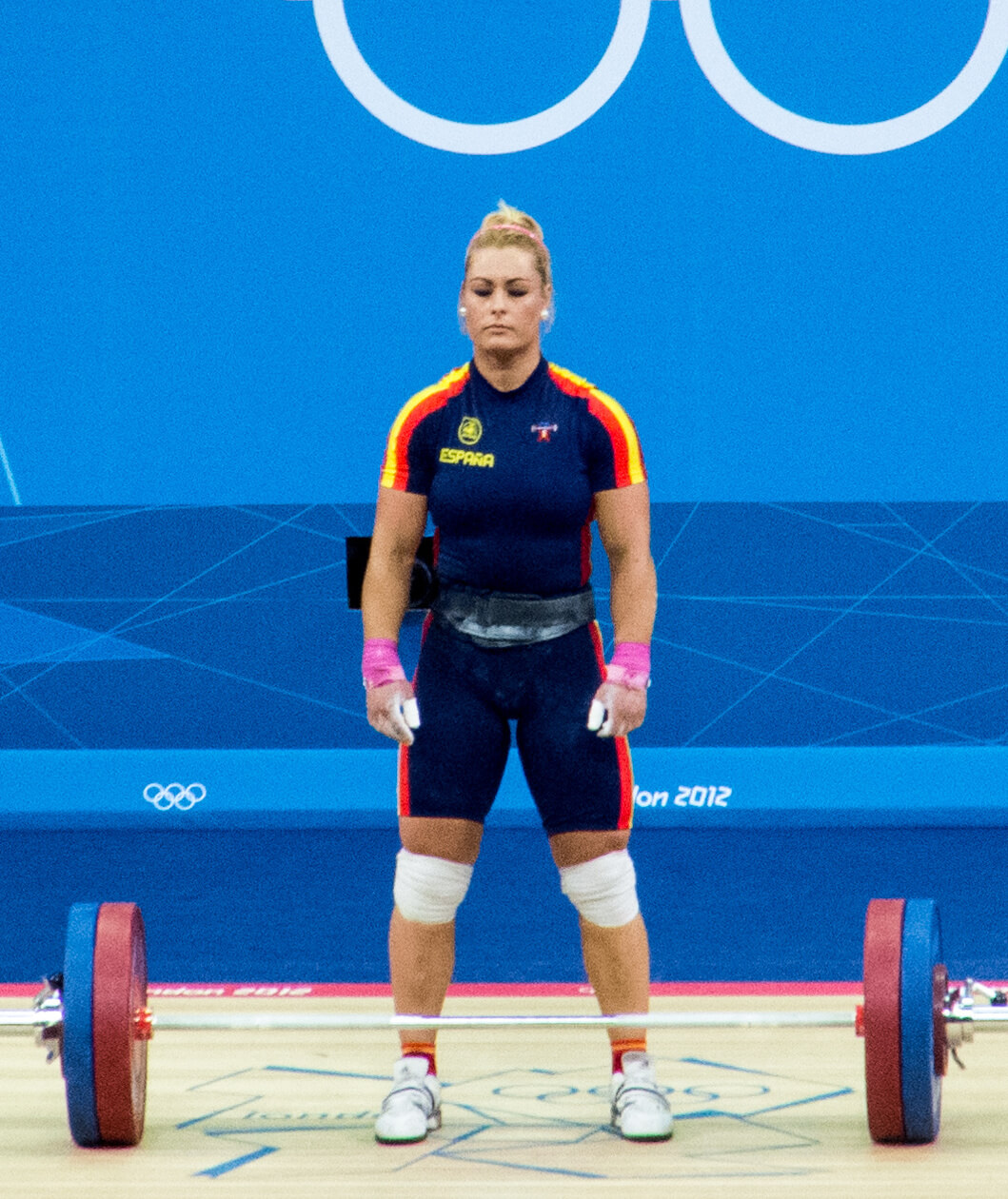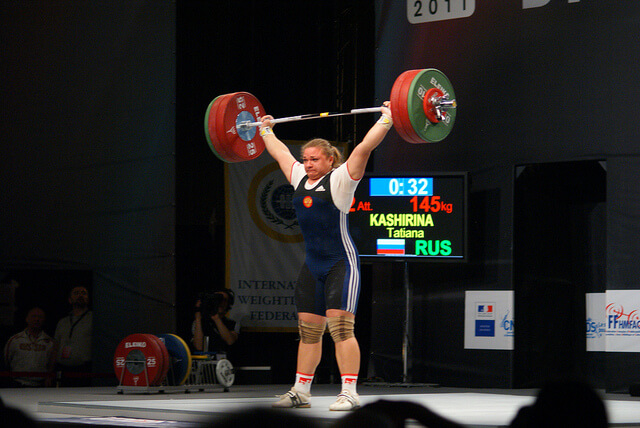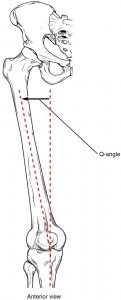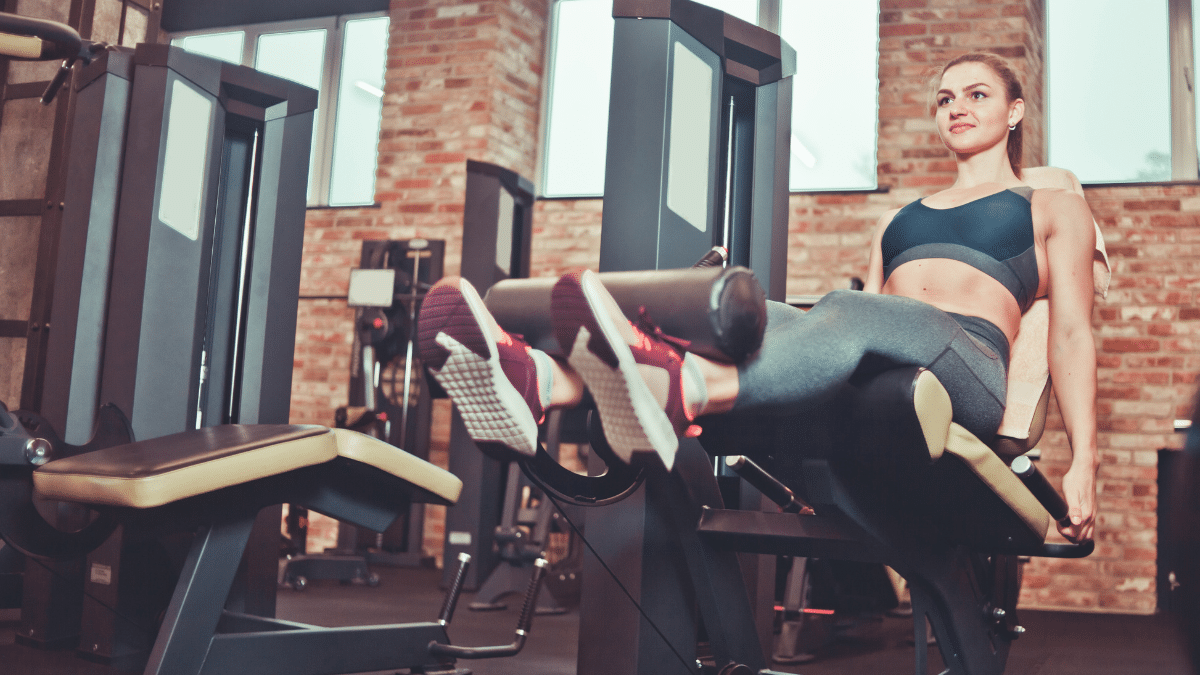What You’re Getting Yourself Into:
~6,100 words, 15-25 minute read time. However, it’s arranged topically, so if there are topics that don’t interest you, feel free to skip over them.
Key Points:
1. Performance varies across the menstrual cycle in some women, related to severity of premenstrual and menstrual symptoms, while purely physiological variables are largely unaffected.
2. Contraceptives largely don’t impact performance or trainability, but can affect emotional and sexual well-being in some women (either positively or negatively).
3. Pre-menstrual symptoms and cravings are very real, but can be improved with exercise and certain nutrition and supplement strategies.
4. Women are at an increased injury risk at certain times in their cycle, but those injury risks can be mitigated with specific training and managing premenstrual and menstrual symptoms.
Almost every woman I’ve talked to about training has questions about how contraceptives and her menstrual cycle can affect training and diet.
This article will (hopefully) clear up most of them.
Just to be up front with how I’m citing sources for this article (since there are roughly 60 journal articles going into it), rather than hyperlinking every source as I come to it (because there are maybe 5-6 sources for a single point, and excessive parenthetical citations make the text less pleasant to read), you can find full text for all the articles I’m referencing in this Dropbox link (edit: I rearranged some files in my dropbox, so this is empty right now. If there are any claims in this article you’d like to see the supporting research for, message me and I’ll send it your way).
Also, before we get rolling, I’d like to give a shout out to Jonathon Mummert. He clued me in to a lot of the research on a few of the topics covered in this article (mainly relating to energy balance and ACL injuries).
Basics/Terminology
A normal menstrual cycle lasts anywhere from 20-35 days, with the average being about 28 days.
The cycle starts on the first day of menses (bleeding). The time between the start of menses and ovulation is called the follicular phase (FP). Ovulation occurs around the middle of the cycle (days 12-16 for most women). The period between ovulation and the start of menses again is called the luteal phase (LP).
The course of the cycle is marked by major changes in four hormones: estrogen, progesterone, follicle stimulating hormone, and luteinizing hormone. All four are low at the start of the cycle. Estrogen levels gradually rise throughout the FP, peaking within a day or two of ovulation, after which point they drop a bit, with another increase in the middle of the LP before hitting a low point on the first day of menses. Progesterone rises very gradually through the FP, and then at a much greater rate during the start of the LP, peaking midway through the LP before dropping off again prior to menses. Follicle stimulating hormone and luteinizing hormone basically stay at the same low level throughout the entire cycle, with the exception of a peak just before ovulation. Of these four, estrogen and progesterone are the ones most relevant to the rest of the article.
Contraceptives are used for a variety of reasons. The most notable, obviously, is to prevent pregnancy by preventing ovulation, inhibiting implantation of the egg into the wall of the uterus by thickening the uterine mucosa, or (usually) both. However, they’re also used to normalize menses, reduce pre-menstrual and menstrual symptoms, and occasionally for competitive reasons. High doses of estrogen or progesterone can be taken at certain times to delay menses prior to a big competition, or to spur menses earlier so it will be over by the time of the competition.
Issues With The Research
Before we dive into the research, I want to be up front about the limitations of it. Usually, I talk about the strengths and weaknesses of individual studies, but since we’ll be covering SO much territory in this article, that would get quite unwieldy. So here are the shortcomings of the literature as a whole (keeping in mind that there are many high-quality studies, especially more recent ones).
- Small sample sizes. This is pretty common in exercise/nutrition research, but it’s especially prevalent here: We’re talking several studies with groups of five people, and a hefty number with 10 or fewer.
- Not using hormone testing to verify phase of the cycle. This isn’t quite as common anymore, but through the early to mid-’90s, the two most common methods for identifying where women were in their cycle were either counting forward or backward from the start of menses (i.e. 14 days after the start of menses would be labeled “ovulatory period,” or three days before menses would be labeled “late luteal period”), or determining follicular/luteal phase based on body temperature (a woman’s temperature usually increases by 0.3-0.5 degrees Celsius or ~.5-1 degree Fahrenheit around the time of ovulation, related to increasing progesterone, before decreasing again around the start of menses). Neither of these methods are necessarily “bad,” but they’re not as accurate as using hormone measurements to pinpoint where women are in their cycle.
- Low progesterone levels in many studies. In studies that did check hormone levels to verify the phases of the cycle, quite a few conducted on athletes found lower-than-normal progesterone levels during the luteal phase. This could indicate non-ovulatory cycles (i.e. you still menstruate, but you didn’t actually release an egg). The conclusions of these studies are questionable for women with normal, ovulatory cycles, because many of the changes seen in the LP are related to progesterone levels. If a study shows no difference between follicular and luteal phases, but progesterone was lower than normal during the LP, you don’t know whether or not there would still be no difference for women with normal cycles and progesterone levels.
- Samples at just two or three time points. Many studies just compare “follicular phase” versus “luteal phase.” However, there are different hormonal mixes at different times during each phase. For example, at the start of the FP (menses), estrogen and progesterone are both low, but by the end, estrogen has peaked while progesterone is still low. In the LP as well, progesterone is low at the start and end, but very high in the middle, while estrogen is still high just after ovulation, drops off a bit, rises again, and then tails off at the end of the LP. So, two studies may be comparing some parameter of performance during the “follicular phase” and “luteal phase,” but they may come to different conclusions based on where in the phases they sampled.
- The multitude of different contraceptives. There’s oral birth control, injectable birth control, implantable birth control devices, hormonal patches, progesterone-only, estrogen-and-progesterone, monophasic, biphasic, triphasic, and different levels of various hormones in each of them. However, many studies just say “birth control users” and “non-users” with the users taking eight different kinds of birth control that may all have slightly different effects lost in the statistical noise.
- HIGH individual variation. This primarily has to do with pre-menstrual and menstrual symptoms. Some women simply have it worse than others. But remember, science deals primarily with averages. As we’ll see, a lot of changes in performance are related moreso to severity of pre-menstrual and menstrual symptoms than to actual physiological changes that limit performance.
- Assuming a 28-day cycle. Many studies (again, not recent ones, but a lot of older ones) simply assumed a 28-day cycle. So they may say they’re testing women during the ovulatory phase (day 14), but that may be four days before ovulation for a woman with a 20-day cycle, or 3-4 days post-ovulation for a woman with a 35-day cycle.
Quality of Life
First things first, the pre-menstrual syndrome (PMS) is a very real thing.
At the risk of being misheard since I can confidently say I’ve never experienced said syndrome, I want to emphasize that I’m not using PMS as a form of gaslighting, and I’m aware of the potential for that term to be used in a derogatory manner. Rather, I’m using it to describe a set of physical and psychological symptoms that have been described in the research, while trying to avoid any implied value judgments about people who experience these symptoms.
It’s estimated that around 85% of women regularly experience at least one PMS symptom, which could include pain, bloating, lethargy, or mood changes. On top of that, 3-8% of women suffer from a more severe form of PMS called pre-menstrual dysphoric disorder (PMDD), which includes symptoms of depression.
During the pre-menstrual period and the first few days of menstruation, most women experience impaired concentration, increased pain, increased negative feelings (including hostility, fear, shame, guilt, anger, contempt, and sadness), and decreased positive feelings (like interest and joy).
However, research has found that regular exercise (the research has looked mainly at moderate intensity, aerobic exercise) can help decrease a lot of those symptoms. Women who exercise typically have lower ratings of pain and negative moods, while also having better concentration at all time points (pre-menstrually, during menstruation, and throughout the rest of the month); it can help alleviate a lot of the downsides that come with pre-menstrual and menstrual symptoms.
Bloating is a particularly interesting topic. Most women report some degree of bloating during the pre-menstrual period and early menses, but the research is actually mixed. Some indicates that women do retain a few extra pounds of water, while some shows no difference.
There are three possibilities (that aren’t mutually exclusive) for what’s actually going on:
- Bloating (true water retention) does occur in some women, but not others, and the differing research findings are due to different mixes of these women being recruited for (often small) studies.
- You don’t actually retain any extra water, but shifts in electrolyte concentrations decrease plasma volume and intramuscular water slightly, redistributing it to interstitial spaces, making you feel more bloated without actual increased water retention.
- The bump of a few pounds on the scale is actually a readjustment due to water loss through the middle of the LP when progesterone is high. Progesterone competes with aldosterone (an adrenal hormone that increases water and salt retention) for the same binding site on the kidney tubules. When it’s elevated, you excrete more water, so aldosterone levels rise. As progesterone drops toward the end of the LP (during the pre-menstrual period), all that aldosterone that built up while progesterone was elevated causes an overshoot in fluid retention. So if you gain 3 pounds on the scale, it may be 1 pound of “extra” fluid retention, and 2 pounds that made up for the extra fluid loss through the middle of the LP.
One last thing worth noting about PMS symptoms and their causes: Some symptoms, particularly headaches and cramping, may be related to calcium and magnesium imbalances. Calcium is necessary for muscle contraction, primarily in smooth muscle like that surrounding your blood vessels. Skeletal muscles store their own calcium in the sarcoplasmic reticulum, so they’re somewhat less affected by small fluctuations in blood calcium and nerve impulses. Magnesium serves the opposite function: aiding in smooth muscle and nerve relaxation (decreasing excitability).
The ratio of calcium to magnesium increases during the late LP, which may contribute to the headaches and cramps women experience as PMS symptoms. This same elevated ratio has been found to cause muscle spasms and contribute to the onset of migraine and tension headaches, so it’s certainly plausible that it could play a role. It may be a good idea to take a magnesium supplement, starting a few days before PMS symptoms usually start through the start of menstruation.
Moving on to contraceptives, there are a lot of conflicting opinions about how various forms of hormonal birth control affect quality of life.
First, a major reason many women go on birth control in the first place is that contraceptives tend to decrease PMS and menstrual symptoms in many (but not all) women, and can be used to iron out menstrual irregularities. This can be a godsend for some women with particularly bad PMS/menstrual symptoms. Some women even use birth control to stop menstruation all together (depending on the kind they use and how they take it). However, as I understand it, completely stopping menstruation is a contentious subject in the medical community and the long-term effects aren’t fully known. Your doctor would be the person to talk to about that – or any birth control-related subject.
However, putting high levels of exogenous hormones into your body can alter how the rest of your endocrine system functions. In the case of birth control, hormonal contraceptives decrease your body’s production of testosterone and DHEA and increase your body’s production of sex hormone binding globulin (SHBG), which binds to androgens and estrogens in your blood stream, rendering them unable to perform the functions they otherwise would. That means, along with reduced production of testosterone, you have an even larger (relative) decrease in free testosterone.
It’s thought that free testosterone plays a major role in regulating mood and sexual interest/function in both men and women. However, different women have different sensitivities to those changes. While some women report negative changes in mood and sexual interest/function when starting birth control, others report positive changes (the results of one survey of a group of 60 women is shown in the table below). Of course, it’s wrongheaded to try to reduce human moods and perceptions to simple hormonal interactions – countering the reduction in free testosterone is decreased stress about the possibility of unwanted pregnancy. Expectations factor in strongly as well: If you expect birth control to affect your mood or sexual function negatively, there’s a greater chance it will.
| No change | Positive change | Negative change | |
| Physical | 8 | 21 | 31 |
| Emotional | 19 | 17 | 24 |
| Sexual | 20 | 20 | 20 |
It’s also worth noting that the increase in SHBG and decrease in free testosterone may not return to pre-contraceptive baselines, even after you stop using. Unfortunately, I’m only aware of a single study that has looked into this relationship, and its subjects were women experiencing sexual dysfunction, so it’s possible that those changes aren’t permanent or semi-permanent in other women.
Training and Performance
Most of the rest of the article will deal with how the menstrual cycle and contraceptives affect different physiological variables related to performance (strength, aerobic capacity, temperature, etc.). However, those variables obviously don’t tell the whole story because performance is a multi-faceted phenomenon. It’s certainly influenced by such physiological variables, but technical skills, strategy, motivation, and arousal all factor in strongly. That makes this section the most important one, and the most interesting (at least to me, and I’m as quick to geek out on some esoteric physiology as just about anyone).
From the outset, be aware that gold medals have been won and world records have been set by women in all menstrual cycle phases. Even at the most elite level, changes in performance during the menstrual cycle are not so big that they abolish differences in skill at the level of competition where “champion” and “also ran” are often separated by fractions of a second or fractions of a percent.
In one survey asking women about their performance during menses, 63% said their performance was unaffected by menstrual phase, 8% said it was worse during menses, and 29% said it was better. In another, 43% reported no change, 38% said it was worse, and 19% said it was better.
Another survey comparing elite athletes to recreational athletes found that only 11% of recreational athletes thought their performance was worse during the pre-menstrual period and menses, while 59% of elite athletes felt their performance was impaired. It seems that training status plays a role: An elite athlete tends to be more in tune with her body and will be more apt to notice minor changes in performance that wouldn’t be noticeable to someone else. However, interestingly, in another survey of Olympians, only 17% said performance was worse during that time period.
One study (not survey) of Hungarian athletes in a variety of sports found that 48.2% of women had no change in performance across their menstrual cycle, 30.7% performed slightly worse during the pre-menstrual period and first few days of menses, and 13.1% performed better.
In another survey, 69.7% of women not taking oral contraceptives said menstruation negatively impacted their performance, while only 31% taking oral contraceptives reported the same. Interestingly, for these women, the primary reason cited for decreased performance wasn’t decreased strength or endurance, but rather increased feelings of lethargy and (I quote) a “can’t be bothered attitude.”
So, taken as a whole, there’s HUGE variation in how much PMS symptoms and menstruation affect performance. Anywhere from 8-70% of women feel like it negatively impacts their performance, while up to 30% feel that performance is improved, while most report no difference. It seems as if these effects are more due to changes in perception and motivation than physiological changes (as we’ll see later), and are related not so much to phase of the cycle itself, but rather to severity of PMS and menstrual symptoms. It also seems like oral contraceptives smooth out a lot of perceived performance variations, probably due to decreasing severity of PMS and menstrual symptoms.
Another thing worth noting here: Quite a few studies show that estrogen tends to decrease spatial abilities and coordination slightly. (Though a couple show no difference, the divergent results are probably related to the difficulty of the tasks used in the studies.) Furthermore, women tend to be more accident-prone during the pre-menstrual period and during menstruation. During this time period, the rate of emergency room visits due to accidents is higher than would be expected. One study found that 52% of women in the ER for accident-related reasons were there during the late LP or during menstruation. However, that’s probably primarily related to lethargy and impaired concentration; if it were due to estrogen levels impairing spatial reasoning, you’d expect higher rates around ovulation or during the middle of the LP.
Aerobic
Aerobic exercise is largely unaffected by menstrual phase and contraceptive usage.
Honestly, the research is all over the board. However, in general, women tend to have a higher RPE at any exercise intensity, higher heart rate and cardiovascular strain, and decreased efficiency during the LP, and some studies even show minor decreases in VO2max. However, several studies have shown increased time to exhaustion during the LP as well, though others show no difference.
Studies investigating substrate usage (fat vs. carbohydrate) have mixed findings as well, and few implemented strict dietary controls anyways.
There are two important takeaways, though.
- During the LP, body temperature is elevated slightly because of increased progesterone levels. This increase in temperature tends to persist during exercise as well, meaning women during the LP may be more susceptible to heat stress if exercising in a hot, humid environment. This elevated temperature also increases ventilation (breathing) rate, both at rest and during exercise (your brain makes you want to breathe a little faster when blood is a little warmer), but that doesn’t actually limit performance, though the feeling of breathing harder can make exercise feel harder.
- Hemoglobin concentrations may be impacted in some women. The average woman loses about 47mL of blood during menses. For context, the average person has about 5L of blood, so a 47mL loss isn’t very much, and the body compensates pretty quickly. However, about 11% of women lose 80mL or more, which can affect hemoglobin concentrations and exercise capacity during menses.
Anaerobic
Basically everything I said about aerobic performance applies to anaerobic performance (most studies use some kind of repeated sprint or shuttle running protocol) as well. For the most part, there’s no difference between menstrual phases or with contraceptive use.
The exception is exercise in hot, humid environments where, again, women tend to perform slightly worse during the LP due to body temperature elevations. That holds true for women on hormonal birth control as well (since there’s not a true luteal phase, that means the second half of their cycle).
Strength
I’ve seen people bandy about a few studies showing women have a 10-20% increase in strength at ovulation. However, the applicability of those studies is questionable.
For starters, many of them use maximum force production with the aid of electrical stimulation to ensure maximum contraction. Unless you’re competing with electrodes hooked up to your muscles, those studies may be relevant for people trying to tease out tiny differences in muscle physiology, but they’re not relevant to you. The rest measure isometric force at a single joint. Since strength performance in any compound movement requires quite a bit of coordination between muscles, a small bump in isometric force at a single joint doesn’t mean much. For example, I doubt Tatiana Kashirina can clean and jerk 193kg on a single day of her cycle, but can only muster 173 for the rest of the month. Not to mention, some of those studies are looking at force production in muscles that are basically irrelevant to performance like the adductor pollicis.
In addition, the majority of studies report no difference anyways (so even if those studies employed exercises and protocols relevant to us, they’d still be in the minority).
In all likelihood, maximal strength doesn’t change much over the course of the menstrual cycle. When taking hormonal contraceptives, the findings are even more straightforward – even the studies using wonky protocols found no strength differences across the cycle in women on hormonal contraceptives. Furthermore, there are no strength differences between women taking hormonal contraceptives and those not taking them.
Moving on to strength gains with training, women experience the same strength gains regardless of whether they’re on birth control.
For example, one study using strength-trained women (college softball and water polo players) employing a pretty solid training protocol (sets of 5-8 on heavy compound lifts, and isolation work in the 10-15 rep “bodybuilding” range) reported great strength gains across the board after 12 weeks, with no differences in strength gains, pre-training strength, and post-training strength between the group taking oral contraceptives and those not taking them.
Another study had similar findings: similar strength gains after 10 weeks of training regardless of whether women were using hormonal birth control or not.
There are two studies that warrant a deeper look, though. They were both conducted as part of a dissertation. The first has been published in a peer-reviewed journal, and I assume the second is in peer review now (it’s basically a repeat of the first study).
In the first study, 20 women trained for 12 weeks. The training was based on their menstrual cycle phases. They did all single-leg, lower body training, using one protocol with one leg, and another protocol with the other leg.
The first protocol (follicular-based training) involved four training sessions per week during the FP of the menstrual cycle, then one training session per week during the LP of the menstrual cycle.
The second protocol (luteal-based training) was the exact opposite: four sessions per week during the LP, and one per week during the FP.
Each subject did one protocol with one leg, and the other protocol with the other leg.
So a week of training during the FP would look like this, with the right leg on the follicular-based protocol, and the left leg on the luteal-based protocol:
Monday: Leg press – 80%1rm, 3 sets to failure with the right leg (increasing weight when they were able to accomplish 12 or more reps in a set)
Wednesday: Leg press – 80%1rm, 3 sets to failure with both legs
Friday: Leg press – 80%1rm, 3 sets to failure with the right leg
Saturday: Single leg squats (that’s what they were called in the study, but I’m assuming they were split squats, not pistol squats) – 3×15-20 with the right leg
For the same person, a week of training during the LP would look like this:
Monday: Leg press – 80%1rm, 3 sets to failure with the left leg (increasing weight when they were able to accomplish 12 or more reps in a set)
Wednesday: Leg press – 80%1rm, 3 sets to failure with both legs
Friday: Leg press – 80%1rm, 3 sets to failure with the left leg
Saturday: Single leg squats (that’s what they were called in the study, but I’m assuming they were split squats, not pistol squats) – 3×15-20 with the left leg
After three cycles of this style of training, the follicular-based training produced substantially better results than luteal-based training. The leg on the follicular-based protocol gained about 42% more strength and 46% more muscle than the one on the luteal-based protocol (an increase in strength of 267N vs. 188N, and an increase in muscle diameter of .59cm vs. .37cm). Furthermore, myonuclei to muscle fiber ratio increased only in the leg on the follicular-based protocol (myonuclei are necessary for muscle repair and remodeling – more of them per unit area is a good thing).

Going back to the follicular-based and luteal-based training study, the same researcher repeated that study using women taking oral contraceptives. The result: the same basic strength and hypertrophy gains seen in the first study (indicating, again, that birth control doesn’t affect strength or hypertrophy gains) but with no differences between follicular- and luteal-based training.
One last thing to note before moving on from this section: Progesterone independently has some androgenic properties. The popular steroids Deca Durabolin and Trenbolone are actually both progestins (hormones in the same chemical family as progesterone). For a time, hormonal contraceptives with high levels of progesterone were actually banned from the Olympics because they were thought to increase muscle and strength gains. However, that assumption has been overturned by research. Sorry, but unfortunately going on Depo-Provera (an injectable progesterone-based contraceptive) doesn’t give you the same gains as a cycle of tren.
Nutrition and Cravings
One of the most common misconceptions about birth control is that it necessarily causes weight gain. However, that’s not true in many cases; it seems to be primarily related to the form of birth control you use.
Combination birth control (estrogen and progesterone) doesn’t seem to cause weight gain. To quote a meta-analysis: “The 3 placebo-controlled, randomized trials did not find evidence supporting a causal association between combination oral contraceptives or a combination skin patch and weight gain. Most comparisons from the 40 trials that compared 2 or more combination contraceptives showed no substantial difference in weight. In addition, discontinuation of combination contraceptives because of weight gain did not differ between groups when this factor was studied.”
The authors conclude that with the available evidence, we can’t know the effects of combination birth control on weight for sure, but “no large effect is evident.”
Progesterone-only birth control is a slightly different story. From a systematic review: “We found limited evidence of weight gain when using POCs (progestin-only contraceptives). Mean gain was less than 2 kg for most studies up to 12 months. Weight change for the POC group generally did not differ significantly from that of the comparison group using another contraceptive. Two studies that assessed body composition showed that POC users had greater increases in body fat and decreases in lean body mass compared to users of non‐hormonal methods.”
The gain may be slightly more for injections (Depo-Provera) than progestin pills or implants. One longitudinal study of 703 women found a 5.1kg greater increase in bodyweight, 4.1kg greater increase in fat, and 3.4% larger increase in body fat percentage relative to combination oral contraceptives or non-hormonal contraceptives when using Depo-Provera.
However, it may not be the progesterone itself that causes weight gain per se (since, after all, the main contributor to weight gain is a positive caloric balance), but rather the effects of progesterone on appetite, which is a good segue into out next topic: cravings and eating patterns.
Estrogen and progesterone have different effects on energy intake. Estrogen tends to decrease appetite and energy intake (probably related to its effects on central leptin sensitivity, as we saw in the last article), and progesterone tends to increase them.
When comparing food intake in the FP versus the LP, women tend to eat more in the LP (when progesterone is elevated). In 30 studies comparing 37 different groups of women, 27 of those groups ate more during the LP, there was no difference for 7 of them, and 4 ate slightly (non-significantly) more during the FP. The typical increase during the LP is 90-500kcal per day.
However, this increase in energy intake is largely compensated for by increased energy expenditure. Progesterone also increases body temperature by raising the thermoregulatory set point in the brain. Along with this increase in body temperature comes a 2.5-11.5% increase in metabolic rate and energy expenditure (89-279kcal per day).
Obviously, there’s a bit of a difference in those numbers (on the top end, 500kcal/day increased intake is a lot higher than 279kcal/day increased expenditure). It’s been proposed that a major difference between normal weight and obese women is that obese women are less sensitive to estrogen’s ability to decrease appetite and energy intake. They tend to have a larger increase in calorie intake during the LP (less sensitive to the ability of estrogen to counterbalance the effects of progesterone on increased energy intake), without a large enough decrease in calorie intake during the FP (when estrogen is rising again) to make up for it.
Unfortunately, the LP is not the best time to be overeating. Progesterone independently promotes fat storage via its effects on lipoprotein lipase in fat tissue, and it decreases fatty acid concentrations in the blood, which can increase cravings for fatty foods. There’s also some (conflicting) evidence that insulin sensitivity may be slightly lower during the LP.
During the LP, cravings for every macronutrient (protein, carbs, and fat) have been reported, probably reflecting personal preferences and just a general increase in appetite. As a whole, most women aren’t particularly good at resisting these cravings either – 85% of women admit to indulging their cravings at least 50% of the time.
However, not all women have cravings with the same frequency or intensity. The strongest predictor is depressive symptoms. Women who tend to be more depressed during the pre-menstrual period (including those with pre-menstrual dysphoric disorder) have more, stronger cravings, which is probably linked to serotonin levels that hit their low point just prior to menstruation. Some women hit a lower low (women with worse PMS symptoms tend to have lower serotonin levels during the pre-menstrual period than women with less severe symptoms), which increases cravings.
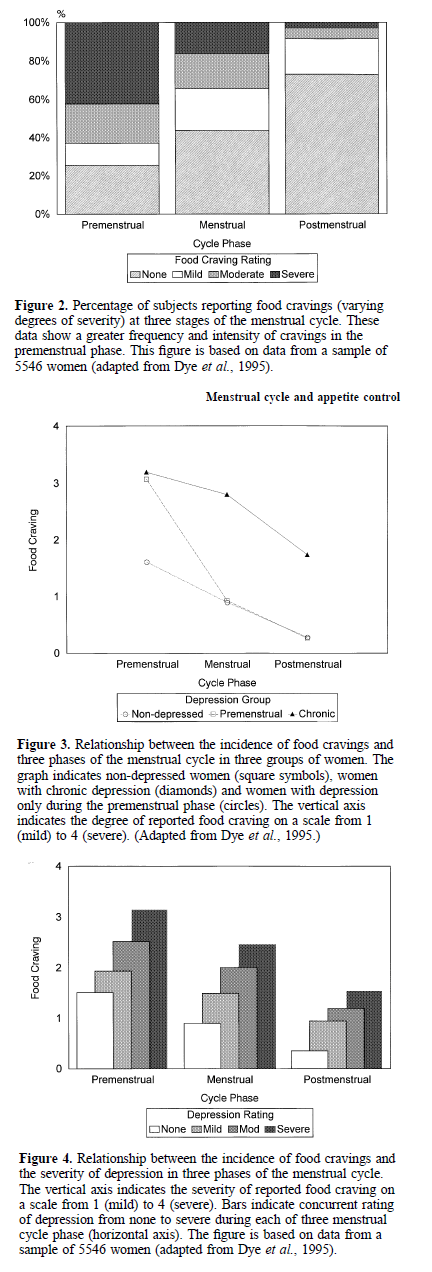
What raises serotonin and makes everything feel better?
That’s right, chocolate. Cheesy stereotype? Perhaps. But it IS the food women report craving the most often.
And it’s not due to some sort of pharmaceutical property of cocoa powder (which doesn’t improve mood and raise serotonin to the same extent) – to quote the authors, the important factor is the “sensory experience involving aroma, sweetness, and texture.” Perceptions of sweetness also change over the course of a cycle. You don’t just think chocolate tastes and smells better during the pre-menstrual period – it actually does taste and smell better.
Furthermore, purposeful carbohydrate consumption has also been shown to partially alleviate PMS symptoms.
Another thing that has been shown to improve PMS symptoms in a lot of women (a halving of symptoms in 50% of women who take it continuously for 3+ consecutive cycles) is vitex agnus castus (or chaste tree fruit).
So, just to recap, women need to be more mindful of their calorie intake during the LP because of a natural urge to eat more. Increasing carbohydrate intake (with the same overall calorie intake) and working some chocolate into your diet will probably help satisfy cravings and decrease PMS symptoms. Taking magnesium before and during the pre-menstrual period may help with cramps by decreasing vascular spasms and nerve hyper-excitability, and taking vitex daily may help reduce PMS symptoms as well.
Injury
Women in competitive sports tend to have higher injury rates than their male counterparts – particularly ACL injuries.
It’s long been assumed that the main reason women have higher ACL injury rates is that they have large Q angles, and people with larger Q angles have higher rates of ACL injuries. Your Q angle (or quadriceps angle) is a measure of the angle of your femur relative to the ground. If you drew a straight line from your anterior inferior iliac spine to your knee cap, another one from your anterior inferior iliac spine to the floor, and found the angle formed by the intersection of those two lines, then congratulations – you’ve found your Q angle.
However, that notion has been called into question. One research review looking at all the studies on people who had gotten arthroplasty or knee replacements found that, actually, the Q angle difference was not a function of sex, but rather a function of height. Since women tend to be shorter than men, they tend to have larger Q angles. However, when adjusting for height (i.e. if you compared a man and a woman of the same height), there’s no difference. Another thing this review pointed out is that women don’t actually have broader hips than men (if your hips are wider, that tends to mean a larger Q angle). Of course, the samples this review looked at may not be representative because they were on people who needed knee surgery, so there’s a chance that the women had normal Q angles, and the men had larger-than-normal Q angles (hence why they needed knee surgery).
Regardless of whether or not a sex difference in Q angles exists, it still wouldn’t tell the whole story, because the Q angle tells you about the alignment of your knee at rest, but most ACL injuries occur during activity.
When comparing men and women in a variety of tasks including cutting drills, hopping, and landing after dropping from a box, there’s a marked difference in joint kinetics and kinematics that expose women to greater ACL injury risks.
Phase of the menstrual cycle plays a role as well. Estrogen increases joint and ligament laxity a bit, and increased knee laxity is seen when estrogen levels are at their peak (around ovulation) both at rest and in cutting and landing maneuvers, increasing the strain on the ACL.
In line with that, several studies have shown that women have a disproportionate amount of ACL injuries around the time of ovulation. Others, however, have shown a greater risk of ACL injuries in the early FP (first few days of menses) versus the LP, which lets us know that estrogen doesn’t fully explain the increased ACL injury risk (since it’s higher in the LP, with the exception of a few days prior to ovulation). It’s been proposed that progesterone may play a protective role.
However, although ACL injury risk is lower during the LP, a woman in the LP is still at a several-fold higher risk of an ACL injury than a man because of those differences in cutting and landing patterns.
BUT it doesn’t have to be that way. Female dancers have the same low rate of ACL injuries as male dancers, and a much lower rate than female team sport athletes.
When comparing landing mechanics between male and female dancers, and male and female team sport athletes, the dancers of both sexes and male team sport athletes have very similar mechanics, but female team sport athletes have significantly different mechanics that place them at a higher risk for ACL injuries. What’s more, a large predictor of landing proficiency when comparing dancers of both sexes is age at which they began training.
So, if you’re a woman participating in sports that require a lot of jumping or cutting (the maneuvers where most non-contact ACL injuries occur), you’d probably benefit by taking some dance classes (particularly ballet). If you have daughters, getting them involved in dance at a young age will probably decrease their ACL injury risk.

As far as contraceptives go, there’s mixed evidence. They mitigate the changes in joint laxity across the cycle, but while some studies show that they decrease injury risk, some show no difference.
Moving on from ACLs, there’s evidence that peak injury risk (all injuries pooled together), at least for soccer players, is during the pre-menstrual period, but only in women with pre-menstrual symptoms, suggesting that the cause for the increase is primarily related to the lethargy and impaired concentration noted previously.
Finally, concussion symptoms tend to be worse in women who suffer a concussion in the LP compared to the FP. Only one study has been conducted on this topic, but the authors posit that progesterone is neuroprotective, so that if you get a concussion during the LP, and progesterone decreases soon thereafter, symptoms worsen and persist for longer (they call this the “withdrawal hypothesis”).
Conclusion/Recommendations
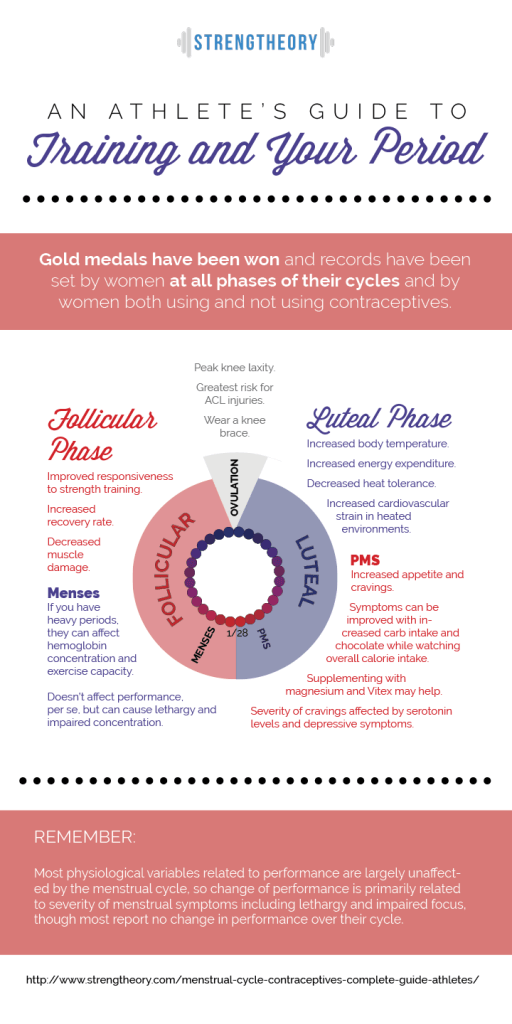
- Most physiological parameters related to performance (strength, endurance, anaerobic capacity, etc.) are largely unaffected by the menstrual cycle or taking hormonal contraceptives.
- Performance may vary throughout the menstrual cycle, but those variations are more a function of PMS/menstrual symptoms including motivation, concentration, and lethargy than changes in physiological variables.
- There’s considerable variation in how much PMS/menstrual symptoms affect women, which may be related to Mg/Ca balance and serotonin levels.
- Regular exercise can lessen the severity of PMS/menstrual symptoms.
- There’s a lot of variation in how contraceptives can make you feel physically, emotionally, and sexually. If you want advice about that stuff, ask your doctor. I’m just a guy who writes about picking up heavy things on the Internet.
- It may be wise to avoid strenuous exercise in hot, humid conditions during the luteal phase because body temperature is slightly elevated.
- Women seem to be able to build strength more efficiently during the follicular phase, perhaps related to decreased muscle damage and faster recovery. That certainly doesn’t mean you shouldn’t train during your luteal phase, but rather that you can probably push yourself a little harder in the gym during the first two weeks of your cycle (including menstruation).
- Hormonal contraceptives don’t limit your ability to gain strength or muscle, but they may “smooth out” the difference in trainability between the follicular and luteal phases.
- Combined contraceptives generally don’t cause an increase in weight, while progestin-only options typically do.
- Eating more carbs and chocolate if you experience PMS symptoms and cravings may help you feel better – just be sure to watch your total calorie intake. Taking vitex consistently may help as well.
- It may be wise to wear a knee brace during the premenstrual period, the first couple days of menstruation, and around the time of ovulation. Additionally, learning proper landing and cutting mechanics (or enrolling in ballet classes) may decrease your risk of ACL injuries.

